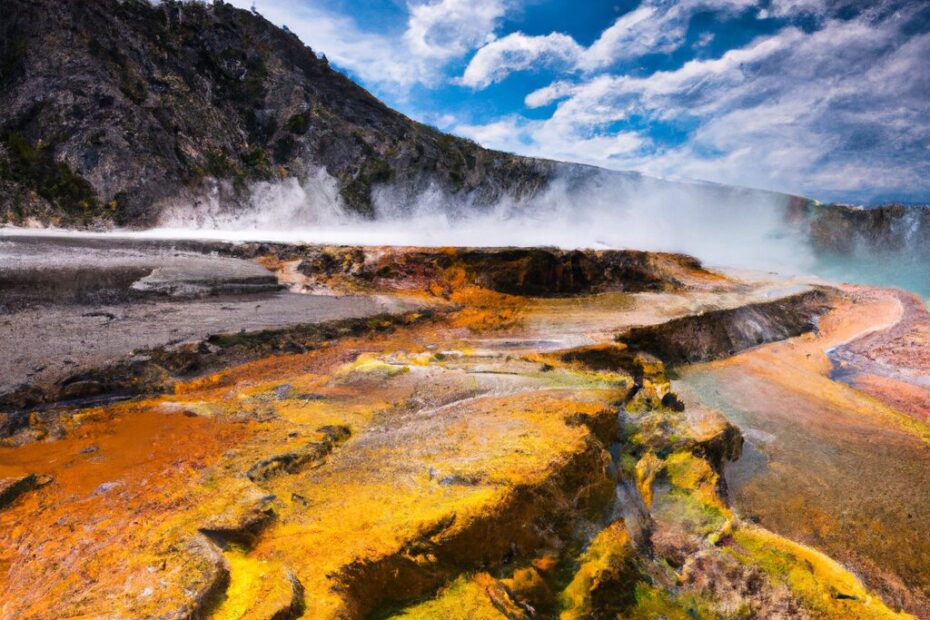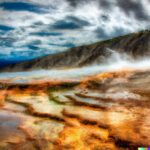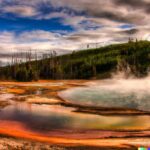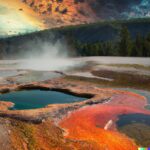Yellowstone National Park is home to some of the most unique geothermal features in the world. From geysers to hot springs, the park boasts a diverse range of natural wonders that continue to captivate visitors year after year.
In this article, we will explore what makes Yellowstone’s geothermal features so special, the main attractions within the park, how these features form, and the precautions that should be taken when visiting. So, get ready to embark on an exciting journey through the geothermal wonders of Yellowstone!
What Makes Yellowstone’s Geothermal Features Unique?
Yellowstone’s geothermal features are renowned for their unique blend of geysers, hot springs, and volcanic activity, creating a mesmerizing display of thermal pools and hydrothermal wonders that contribute to the park’s biodiversity and natural wonders.
Location on a Volcanic Hotspot
Yellowstone’s geothermal features owe their existence to the park’s location on a volcanic hotspot, contributing to the formation of distinct geological formations and the park’s designation as a national park.
The volcanic hotspot beneath Yellowstone has fueled the creation of iconic features such as geysers, hot springs, and mud pots. This unique geological activity has drawn researchers and visitors alike, showcasing the park’s dynamic and ever-changing landscape.
The volcanic activity played a pivotal role in the establishment of Yellowstone as the world’s first national park, recognizing its exceptional natural value and preserving it for future generations to experience and marvel at its wonders.
Large Concentration of Geysers and Hot Springs
Yellowstone boasts a large concentration of geysers and hot springs, forming unique landscapes and contributing to the park’s vibrant geothermal ecosystem, characterized by diverse thermal features.
Yellowstone National Park is home to a variety of thermal features, including famous ones like Old Faithful, Castle Geyser, and Grand Prismatic Spring. These stunning natural wonders not only provide a visual spectacle, but also play a crucial role in shaping the geothermal environment of the park.
The hot springs in Yellowstone come in a range of colors and formations, creating a surreal and mesmerizing backdrop for visitors. The eruptions of geysers, some of which are predictable while others are spontaneous, add an element of excitement and unpredictability to the landscape, making each visit a unique experience. It’s safe to say that the geothermal features in Yellowstone truly define the park’s distinct and dynamic character.
Diversity of Geothermal Features
The diversity of Yellowstone’s geothermal features encompasses fumaroles, steam vents, mud pots, and other hydrothermal wonders, showcasing the geological processes that give rise to natural steam baths and captivating thermal phenomena.
The geothermal features found in this park offer a captivating look into the Earth’s dynamic forces. Visitors can witness the intense interaction between water and heat, resulting in stunning displays of bubbling mud, erupting steam, and vibrant mineral deposits. From the eerie hiss of steam escaping from fumaroles to the rhythmic gurgling of mud pots, each feature adds to the park’s one-of-a-kind landscape. These features serve as a testament to the ongoing geological activity happening beneath the surface.
What Are the Main Geothermal Features in Yellowstone?
Yellowstone’s main geothermal features, including the iconic Old Faithful Geyser, the vibrant Grand Prismatic Spring, the majestic Mammoth Hot Springs, the dynamic Norris Geyser Basin, and the intriguing Mud Volcanoes, collectively contribute to the park’s appeal as a unique geothermal wonder.
Old Faithful Geyser
The Old Faithful Geyser stands as a prominent geothermal attraction in Yellowstone, symbolizing the park’s volcanic activity and contributing to its status as a natural wonder.
Old Faithful, with its majestic eruptions shooting boiling water up to 184 feet into the air, captivates visitors from around the world. This iconic geyser’s predictable and frequent eruptions occur approximately every 90 minutes, making it a reliable natural spectacle.
But Old Faithful’s significance goes beyond its visual appeal. As an integral part of Yellowstone’s unique geothermal landscape, it offers insights into the Earth’s inner workings and the powerful forces shaping this extraordinary national park.
Grand Prismatic Spring
The Grand Prismatic Spring captivates visitors with its vibrant colors and remarkable thermal features, shaping unique landscapes and contributing to Yellowstone’s diverse geothermal ecosystem.
Yellowstone National Park boasts a breathtaking natural wonder, known as Grand Prismatic Spring. Its stunning hues, including vivid blues and oranges, result from the presence of thermophiles, heat-loving microorganisms, adding to the allure of this natural wonder.
The geothermal activity around the spring creates striking terraces, showcasing the dynamic interaction between geology and biology. This hotspot of geothermal activity influences the formation of mineral deposits, contributing to the distinct geological formations found throughout Yellowstone National Park.
Mammoth Hot Springs
Mammoth Hot Springs showcases captivating hydrothermal features and geological processes, contributing to Yellowstone’s array of geothermal wonders and natural marvels.
The terraces of Mammoth Hot Springs are a mesmerizing sight, with their vibrant colors and constantly shifting formations, a testament to the power and beauty of nature’s forces.
The unique limestone formations, shaped by hot springs and travertine deposits, create an otherworldly landscape that continues to evolve over time. This stunning display of geological activity offers visitors a rare and remarkable opportunity to witness the dynamic processes that shape the Earth’s surface, making it a must-see destination in Yellowstone National Park.
Norris Geyser Basin
The Norris Geyser Basin offers a remarkable display of thermal pools and unique landscapes, cementing its position as a geothermal attraction and a contributor to Yellowstone’s array of geothermal wonders.
Visitors to this natural wonderland are greeted by the sight of vibrant and strikingly colorful thermal pools, each with its own distinct hue and mesmerizing steam rising from the earth.
The basin’s unique landscape, sculpted by the geothermal activity, showcases the awe-inspiring power of nature as steam vents, geysers, and fumaroles paint a picture of an otherworldly environment. The interplay between the earth’s geothermal forces and the creation of these breathtaking natural formations exemplifies the ongoing dynamic geologic processes, offering a captivating insight into the Earth’s natural history and its ability to shape landscapes in incredible ways.
Mud Volcanoes
The Mud Volcanoes showcase intriguing geological formations and contribute to Yellowstone’s geothermal wonders, serving as a unique geothermal attraction within the park.
These mud volcanoes are characterized by their bubbling and churning mud pools, producing a dramatic display of geothermal activity. Visitors are captivated by the vibrant colors and textures of the mineral-rich mud, creating an otherworldly landscape.
This distinctive feature adds to the allure of Yellowstone’s geothermal wonders, attracting curious travelers and geology enthusiasts alike. The mud volcanoes play a crucial role in showcasing the dynamic and ever-changing nature of the park’s geothermal activity, making them an essential stop for those exploring Yellowstone’s unique natural phenomena.
Fumaroles and Steam Vents
The presence of fumaroles and steam vents in Yellowstone signifies the dynamic thermal and hydrothermal activity, adding to the allure of the park’s geothermal features and unique landscapes.
These geothermal features not only create visually stunning landscapes but also serve as a constant reminder of the Earth’s powerful and ever-changing geological processes.
The fumaroles release steam and gases while the steam vents emit hot water and steam, showcasing the intense heat and pressure beneath the surface. This continuous activity shapes the otherworldly terrain of Yellowstone, making it a living laboratory for scientists and a source of wonder for visitors from around the world.
How Do These Geothermal Features Form?
The formation of Yellowstone’s geothermal features is a result of volcanic activity, the presence of a heat source from the Earth’s core, the interaction with microbial life, and the geological processes that fuel the park’s hydrothermal activity and geothermal energy.
Volcanic Activity and Heat from the Earth’s Core
The geothermal features in Yellowstone form due to the combination of intense volcanic activity and the heat emanating from the Earth’s core, which fuels the park’s unique geological processes, hydrothermal activity, and geothermal energy.
This interplay of volcanic activity and core heat creates an environment where geysers, hot springs, mud pots, and fumaroles thrive. The volcanic eruptions deposit minerals, forming vibrant terraces and colorful pools.
The heat from the Earth’s core drives the circulation of water through the park’s hydrothermal system, creating a rich source of geothermal energy. As a result, Yellowstone’s geothermal features serve as a testament to the powerful forces at work beneath the Earth’s surface.
Superheated Water and Pressure
The interaction of superheated water and pressure within Yellowstone’s geothermal features contributes to the park’s unique thermal activity, providing opportunities for geothermal exploration and scientific study of the park’s hydrothermal phenomena.
This combination of superheated water and pressure plays a critical role in shaping the park’s stunning geothermal features, such as hydrothermal vents, geysers, and hot springs.
These natural wonders are formed through the intense pressure and temperature exerted by the superheated water beneath the Earth’s surface, resulting in an array of captivating thermal displays that have captivated scientists and visitors alike.
The presence of superheated water and pressure has facilitated extensive research, allowing scientists to delve deeper into understanding the complexities of Yellowstone’s hydrothermal activity and its broader impact on the region’s geology and ecosystem.
Microorganisms and Unique Ecosystems
The presence of microorganisms within Yellowstone’s geothermal features fosters unique ecosystems and underscores the importance of environmental protection to preserve the park’s geothermal ecosystem and biodiversity.
These microorganisms, through their interaction with the extreme conditions of the geothermal features, contribute to the formation of vibrant and specialized habitats. The intricate balance maintained by these tiny organisms sustains a web of life within these extreme environments, highlighting the fragility and resilience of the ecosystem.
Preservation of this delicate balance is vital for ensuring the continuation of diverse species that have adapted to thrive in the geothermal features of Yellowstone National Park.
What Precautions Should Be Taken When Visiting Yellowstone’s Geothermal Features?
Visitors to Yellowstone’s geothermal features should exercise caution and adhere to safety signs and designated trails to ensure the conservation of these thermal attractions and guarantee environmental protection within the park.
Stay on Designated Trails
It is vital for visitors to Yellowstone’s geothermal features to stay on designated trails, respecting safety signs and contributing to the conservation and environmental protection of these natural wonders.
By staying on designated paths, visitors can ensure the safety of themselves and the delicate ecosystem surrounding the geothermal features. This not only avoids potentially hazardous areas, but also helps in preserving fragile plant life and the habitat of the park’s wildlife.
Trampling off trails can cause irreparable damage to the fragile ecosystem and disrupt the natural balance of the park. By following designated paths, visitors play a crucial role in safeguarding the unique geological formations and maintaining the natural beauty of this iconic national park.
Follow Safety Signs and Warnings
Visitors must diligently follow safety signs and warnings when exploring Yellowstone’s geothermal features, ensuring their safety and the preservation of these captivating thermal attractions.
This commitment to adhering to safety measures is essential to safeguarding both visitors and the unique geothermal formations that make Yellowstone National Park a breathtaking destination.
By respecting the warnings and guidelines set forth by park authorities, visitors contribute to the preservation of these natural wonders for future generations to enjoy. Understanding the potential hazards and heeding the advice provided facilitates a responsible and enjoyable exploration of Yellowstone’s fascinating geothermal features.
Do Not Touch or Step on Geothermal Features
It is imperative for visitors to refrain from touching or stepping on Yellowstone’s geothermal features, adhering to safety precautions and contributing to environmental conservation within the park.
Geothermal features, such as hot springs, geysers, and mud pots, are delicate formations that can be easily damaged by human interference. It is important for visitors to respect safety guidelines and stay on designated paths to preserve these unique ecological wonders for future generations to enjoy.
By following these precautions, not only is personal safety ensured, but the overall ecological balance of the park is also supported. This promotes a sustainable and harmonious coexistence between visitors and the natural environment.
Frequently Asked Questions
What are the unique geothermal features in Yellowstone?
Some of the unique geothermal features in Yellowstone include hot springs, geysers, mud pots, fumaroles, and steam vents. These are all a result of the park’s volcanic activity and make it one of the most unique places to visit in the world.
What makes these geothermal features in Yellowstone unique?
The geothermal features in Yellowstone are unique because of the high concentration and variety of them. The park has over 10,000 geothermal features, which is half of all the geothermal features in the world. Additionally, the vivid colors and constant activity of these features make them truly one-of-a-kind.
Why are there so many geothermal features in Yellowstone?
The presence of geothermal features in Yellowstone is due to the park’s location on top of a supervolcano. This causes the geothermal heat to be closer to the surface, resulting in a greater concentration of features compared to other areas.
What is the most famous geothermal feature in Yellowstone?
The most famous geothermal feature in Yellowstone is Old Faithful. This geyser is known for its predictable eruptions, which occur roughly every 90 minutes and can shoot up to 180 feet in the air.
Are the geothermal features in Yellowstone safe to visit?
While the geothermal features in Yellowstone are one of the park’s main attractions, they can also be dangerous. Visitors are advised to stay on designated paths and boardwalks and not to touch or throw objects into the features, as the water can reach extremely high temperatures.
Can you swim in the geothermal features in Yellowstone?
No, swimming is not allowed in any of the geothermal features in Yellowstone. The water in these features can reach temperatures above boiling and can cause severe burns. Additionally, swimming can disturb the delicate balance of these unique natural wonders.
Last Updated on January 25, 2024 by Jon Waraas – Originally Posted: January 25, 2024

I’m Jon Waraas, and I’ve been navigating the online world since 2006. By day, I’m the proud owner of some eCommerce gems, and by night, I’m the voice behind the adventures on Waraas.Com.
My heart, however, belongs to the wild beauty of Yellowstone National Park. I’ve got a collection of websites dedicated to sharing the wonders of this natural masterpiece. Oh, and did I mention? I’m currently building my own cabin inside the ghost town of Gilmore, Idaho – a cabin with tales to tell!
When I’m not immersed in the digital realm, you’ll find me lacing up my boots for a good hike or setting up camp under the star-studded sky.




